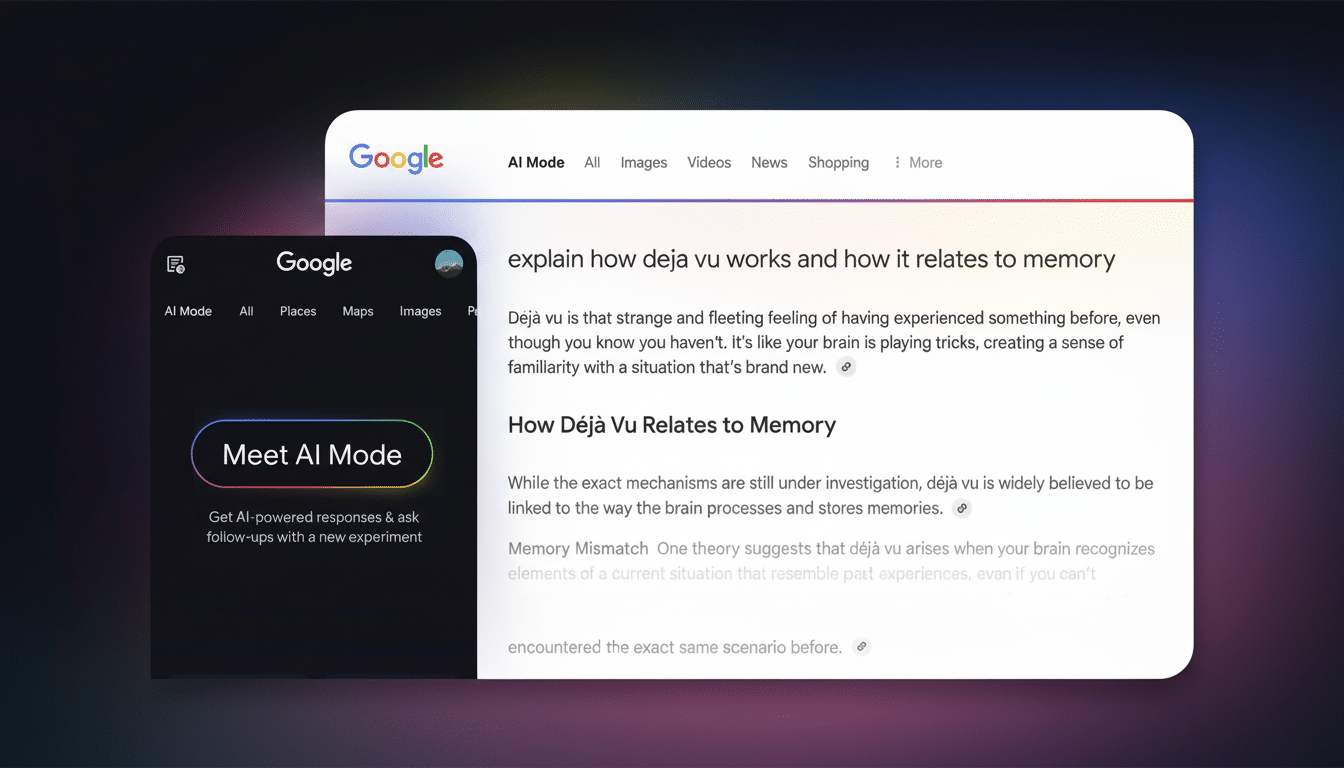The future has finally arrived in an AI (Artificial Intelligence) mode of Google Search. Users are now starting to encounter sponsored results alongside AI-generated answers, so the honeymoon for an experience that had until recently been ad-free has come to a close.
What Users Are Seeing in Google’s AI Mode Ads
Early sightings were from industry watchers who saw sponsored cards that read “Sponsored” within AI Mode in service-related queries, such as local HVAC repair. Significantly, these placements are appearing in both Google’s experimental Labs interface and in the regular Search experience, suggesting a wider rollout that goes beyond a closed test.

The new layout of ads you see at the end of an AI response fits right in and follows the same visuals that link cards in AI Mode already share. In practice, that means users first see a synthesized answer, and after that they get sponsored options that imitate organic result cards instead of the familiar blue-link ads of days gone by. And although the position is old school, the design is very much a native AI interface.
Why Google Is Bringing Advertising to AI Mode
The monetization was not an if, it was a when. Advertising, according to company filings, is still the chief profit driver for Alphabet’s business — and generative AI experiences run computationally expensive when scaled. Ads in AI Mode help to bring the business model a step closer to a product experience that is front-and-center today in Search.
Google has already offered a preview of its plans. The company started running ads within AI Overviews on mobile last year, and during the Google Marketing Live show earlier this month executives pointed to new AI-centric formats. AI Mode is the next step, as the company pushes monetization into Search’s chat-like, task-driven side meant to remove friction for users.
How These New AI Mode Ads Fit Google’s Ad Auction
AI Mode combines retrieval with generation, which alters the setting for ad auctions. Instead of bidding for a traditional top-of-SERP slot, ads are competing to appear in a curated module located below an AI-generated answer. Which begs the question about how Quality Score, query intent, and contextual relevancy will be weighted where the “page” is effectively an AI-generated summary.
For service and local intent, the format appears custom-built for Local Services Ads and lead-gen campaigns where trust signals and proximity come into play. For commerce, consider Merchant Center feeds, product images, and more signals to help inform which ads populate in AI cards. Google’s public guidance has focused on clarity of labeling and relevance, which regulators and the IAB Tech Lab will be monitoring closely.

What It Means for Advertisers and SEOs in AI Mode
Early volatility in click-through rates is expected as user behavior adjusts. If the answer shows up first, fewer users have to scroll and hence any ads actually seen may receive higher intent clicks. Measurement teams should anticipate a space between assisted actions (users who do receive what they need from the AI response) and last-click results, and monitor new impression and “AI engagement” metrics from Google to address that gap.
For SEO, AI Mode prefers pages that can be easily summarized and fact-checked. Good structured data, transparent sourcing, and authoritativeness in the content enable the model to surface high-quality snippets. But the introduction of ads means organic visibility exists together with paid competition even in AI-native surfaces. Over time, analysts at Similarweb and other companies have recorded an increase in zero-click behavior; AI-aided answers may turbocharge such behavior, making brand visibility within AI summaries and the adjacent ad units more strategically significant than ever.
User Trust and Policy Guardrails for AI Mode Ads
Labeling is the line Google has to walk. Regulators like the US FTC and UK ASA have raised the bar for what is expected in clear disclosure and anti-deceptive design. “Sponsored” in AI Mode is table stakes; placement, prominence, and repetition will dictate whether users perceive the difference between answer and ad is clear.
Accuracy matters, too. If an AI response hallucinates while a sponsored card is placed directly below it, users could mistake the two for related content. That risk places pressure on Google’s safety systems and on advertisers to make sure landing pages live up to the claims. Trusted industry researchers like the Nielsen Norman Group have warned about how trust can quickly erode when interfaces blur content boundaries; AI Mode’s layout will be placed under this microscope.
What to Watch Next as Google Expands AI Mode Ads
The rollout seems tactical in nature: ads occur below the AI response, the creative mimics organic cards, and inventory is limited to service-heavy queries. But knobs can turn quickly. Look for experiments that push ads higher up in the module, richer commerce cards, or interactive elements such as appointment booking or lead forms within the AI surface.
For the moment, the takeaway is straightforward. AI Mode is no longer a search outlier from Google. Advertisers should be testing placements and creative built for AI summaries, SEOs should be optimizing for extractability and attribution, and all of us will need to keep an eye on how this new ad real estate reshapes the attention map of the results page.

